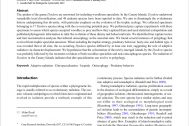Obsah
The spiders of the genus Dysdera are renowned for including woodlouse specialists. In the Canary Islands, Dysdera underwent remarkable local diversification, and 48 endemic species have been reported to date. We aim to disentangle the evolutionary history underpinning this diversity, with particular emphasis on the evolution of the trophic ecology. We collected specimens belonging to 17 Dysdera species along with the co-occurring potential prey. We performed prey capture experiments with these specimens to assess which species accepted woodlice as prey and how they captured them and used statistical extrapolation and published phylogenetic information to infer the evolution of these dietary and behavioral traits. We identified four capture tactics and trait reconstruction analyses that inferred oniscophagy as the ancestral state. We found several instances of polyphagy that evolved from trophic specialist ancestors. When including the trophic strategy, predatory behavior, body size, and habitat type, it was revealed that at all sites, the co-occurring Dysdera species differed by at least one trait, suggesting the role of adaptive radiation via character displacement. We hypothesize that the colonization of the newly emerged islands by the Dysdera species was probably followed by the recurrent evolution of both woodlice specialists and non-oniscophagous species. The radiation of Dysdera in the Canary Islands indicates that diet specialization can evolve to polyphagy.



